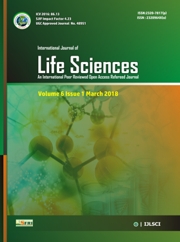RESEARCH ARTICLE
Volume 7 |Issue 6| November-December 2019 First published: 30 December 2019
Comparative study on phytochemical analysis of Andrographis paniculata, Tinospora cordifolia and Withania coagulans
Dewalkar LP1* and Dikondwar SV2
1Department of Zoology, Gurunanak College of Science, Ballarpur (MS), India
2Department of Chemistry, Gurunanak College of Science, Ballarpur (MS), India
*Corresponding Author: L. P. Dewalkar lalitzoology@gmail.com
E. mail: naqvin@rediffmail.com
Abstract
Keywords:Andrographis paniculata, Tnispora cordifolia, Withania coagulans, TLC, secondary metabolite.
Editor: Dr.Arvind Chavhan
Cite this article as:
Dewalkar LP and Dikondwar SV. Comparative study on phytochemical analysis of Andrographis paniculata, Tinospora cordifolia and Withania coagulans, Int. Res. Journal of Science & Engineering, 2019, 7 (6): 173-178.
References
1. 1. Gabrielian, E. S., A. K. Shukarian, G. I. Goukasova, G. L. Chandanian, Alexander George Panossian, G. Wikman, and Hildebert Wagner. "A double blind, placebo-controlled study of Andrographispaniculata fixed combination Kan Jang in the treatment of acute upper respiratory tract infections including sinusitis." Phytomedicine 9, no. 7 (2002): 589-597.
2. Mukherjee, Pulok K., KuntalMaiti, Kakali Mukherjee, and Peter J. Houghton. "Leads from Indian medicinal plants with hypoglycemic potentials." Journal of ethnopharmacology 106, no. 1 (2006): 1-28.
3. Pérez, Cristina, and Claudia Anesini. "Antibacterial activity of alimentary plants against Staphylococcus aureus growth." The American journal of Chinese medicine 22, no. 02 (1994): 169-174.
4. Sudhir, S., R. D. Budhiraja, G. P. Miglani, B. Arora, L. C. Gupta, and K. N. Garg. "Pharmacological studies on leaves of Withaniasomnifera." Planta medica 52, no. 01 (1986): 61-63.
5. Umeh, E. U., H. O. A. Oluma, and J. O. Igoli. "Antibacterial screening of four local plants using an indicator-based microdilution technique." African Journal of Traditional, Complementary and Alternative Medicines 2, no. 3 (2005): 238-243.
6. Harborne, JEFFREY B. "Phenolic compounds." In Phytochemical methods, pp. 33-88. Springer, Dordrecht, 1973.
7. Harborne, A. J. Phytochemical methods a guide to modern techniques of plant analysis. springer science & business media, 1998.
8. Wang, Z. T., and G. Y. Liang. "Zhongyaohuaxue." Shanghai Scientific and Technical (2009).
9. Lu, Jin-Jian, Jiao-Lin Bao, Xiu-Ping Chen, Min Huang, and Yi-Tao Wang. "Alkaloids isolated from natural herbs as the anticancer agents." Evidence-based complementary and alternative medicine 2012 (2012).
10. Tang, Jun, Yibin Feng, SaiwahTsao, Ning Wang, Robert Curtain, and Youwei Wang. "Berberine and Coptidisrhizoma as novel antineoplastic agents: a review of traditional use and biomedical investigations." Journal of ethnopharmacology 126, no. 1 (2009): 5-17.
11. Chan, Eli. "Displacement of bilirubin from albumin by berberine." Neonatology 63, no. 4 (1993): 201-208.
12. Chan, T. Y. "The prevalence use and harmful potential of some Chinese herbal medicines in babies and children." Veterinary and human toxicology 36, no. 3 (1994): 238-240.
13. Dogra, Ram KS, Santosh Khanna, and Ravi Shanker. "Immunotoxicological effects of piperine in mice." Toxicology 196, no. 3 (2004): 229-236.
14. Daware, Mahadeo B., Arvind M. Mujumdar, and SurendraGhaskadbi. "Reproductive toxicity of piperine in Swiss albino mice." Planta medica 66, no. 03 (2000): 231-236.
15. Unchern, Surachai, Hiroshi Saito, and Nobuyoshi Nishiyama. "Selective cytotoxicity of piperine on cultured rat hippocampal neurons in comparison with cultured astrocytes: the possible involvement of lipid peroxidation." Biological and Pharmaceutical Bulletin 20, no. 9 (1997): 958-961.
16. Okhuarobo, Agbonlahor, Joyce EhizogieFalodun, OsayemwenreErharuyi, Vincent Imieje, AbiodunFalodun, and Peter Langer. "Harnessing the medicinal properties of Andrographispaniculata for diseases and beyond: a review of its phytochemistry and pharmacology." Asian Pacific journal of tropical disease 4, no. 3 (2014): 213-222.

